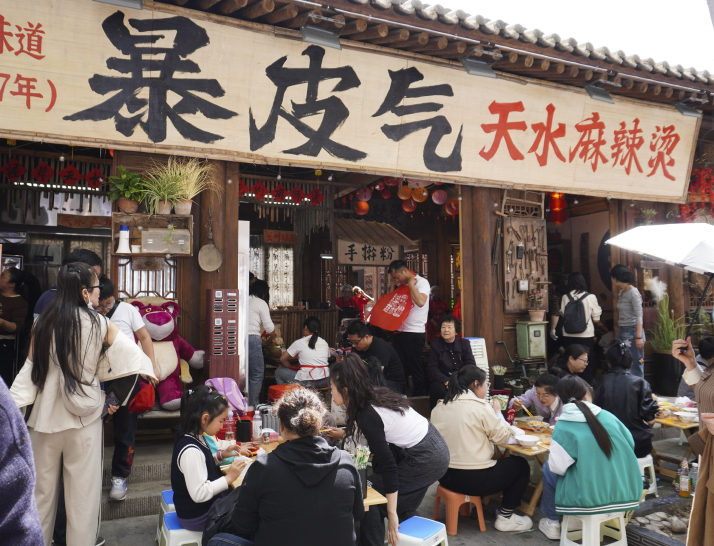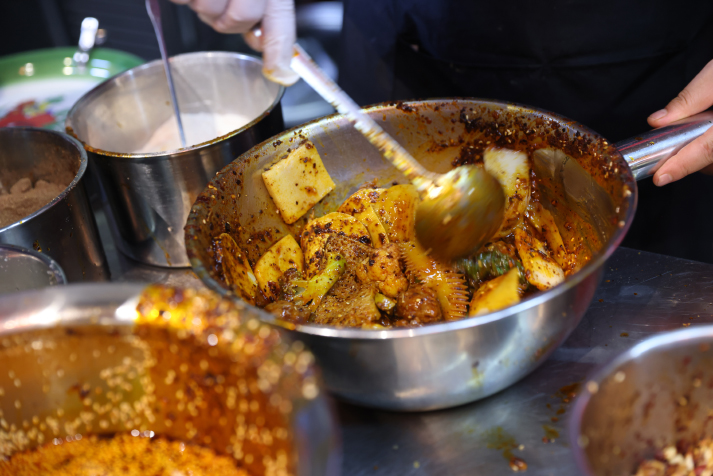| China |
| Popular Chinese street foods capture global culinary palates | |
|
|
 Customers enjoy malatang at a restaurant in Tianshui, Gansu Province, on April 4 (XINHUA)
Malatang, a Chinese dish originating from Sichuan cuisine in southwest China, is known for its flavorful yet almost tongue-numbing broth, which is cooked with a selection of ingredients, including meats, vegetables, tofu and noodles. A firm favorite among many residents of China, today, this spicy sensation is now gaining popularity far beyond the country's borders. Chinese malatang has gone viral in Japan. Posts on major social media platforms such as microblogging platform Weibo show that numerous malatang restaurants in Japan have become bonafide culinary hotspots, often with long lines of eager patrons outside. Diners are drawn to the dish's bold flavors and highly customizable options. Beyond malatang, other Chinese street foods, including hotpot, baozi (steamed buns) and jianbing (savory crepes), are also being embraced globally. Hotpot is a traditional Chinese dish, a social experience even, where a simmering pot of broth is placed at the center of the table, and diners cook raw ingredients like meats, vegetables, tofu, and noodles by dipping them into the boiling broth. Their rising popularity is fueled by a growing interest in authentic regional cuisines and the social trends surrounding more "global" dining experiences. Healthy and customizable Malatang literally translates to "numb, spicy and hot" in Chinese. Its defining characteristic is its rich broth, infused with a blend of spices, including Sichuan peppercorns, chili oil, garlic and other seasonings. The result is a fiery flavor—a hallmark of Sichuan cuisine. There are several stories about the origin of this dish, but one of the most popular is that it was created by boatmen and porters along the Yangtze River as a quick and convenient meal. Using simple tools like clay pots and dry firewood, they would add chili peppers and Sichuan peppercorns to the pot, cooking their ingredients on the spot. This method of cooking and eating also helped ward off the cold and dampness of the river environment. Over time, this rustic style of dining spread and blended with other regional culinary traditions, evolving into the malatang we know today. As health awareness is on the rise, modern malatang has started to shift toward using bone broth as its base. This variety uses a rich, savory broth made from pig and beef bones, resulting in a lighter flavor compared with the traditional spicy version. Zhangliang, one of the most popular malatang brands, is renowned for its bone broth and fresh ingredients, boasting 6,000 stores worldwide, including over 80 overseas locations in more than 15 countries. Another popular brand, Yangguofu, has opened stores in more than 20 countries. "These stores are frequented by both Chinese customers and, increasingly, by locals," Liang Yanwen, who is in charge of membership at Yangguofu, said in an interview with news portal IFeng.com. The low-calorie vermicelli and customizable ingredients have attracted many customers in Japan. According to Japanese TV program TBS News, most customers visiting the restaurant are women, with social media posts often revealing that some patrons were introduced to the dish by their fitness trainers. "From a health perspective, the freedom to customize and the abundance of vegetables make it a relatively healthy food. Capsaicin [the chemical in chili peppers responsible for their heat] stimulates the metabolism, increasing calorie burning," Luo Chaofan, a rehabilitation therapist at the National Health Commission of China, told newspaper Global Times. In contrast to traditional Chinese malatang, the version found in the Republic of Korea also features a lighter broth and milder spiciness. The reduction of spices and oil has been a key factor in its success in the country. As an emerging trend in Korean food culture, some food companies have also introduced malatang-flavored ramen, fried chicken and other locally popular products. In October 2023, the first Yangguofu store opened in Düsseldorf, Germany, covering approximately 300 square meters. On its opening day, the store sold over 700 bowls of malatang, setting a record for the highest single-day sales across its global locations, with a line of customers stretching out into the street. "Located in [Düsseldorf's] bustling business district, the store's décor style combines modern aesthetics with different Chinese elements," Lena Fu, a Chinese working in Germany's Cologne City who has visited the Yangguofu store in Düsseldorf, told Beijing Review. "Warm soup and colorful ingredients perfectly match the winter season."  Malatang is ready to win over global diners' taste buds (XINHUA)
More than food Malatang is just one example of Chinese street food making waves in the world. Tanghulu, a traditional Chinese snack, is winning the hearts of many children and young people overseas. It consists of sugar-coated fruit skewered on a stick. Typically, it uses hawthorn berries, but other fruits, such as strawberries, grapes and mandarin segments, can also be coated in sugar. The fruit is first washed, then skewered and dipped in hot sugar syrup, which hardens as it cools, creating a crunchy, sweet coating. Tanghulu is often sold by street vendors, especially during festivals and in winter, and is beloved for the contrast between its sweet, crunchy exterior and the tartness of the fruit inside. In February, right after the traditional Chinese New Year (or Spring Festival), a young woman named Wang Yibei from Chongqing Municipality, who had just obtained her masters' degree in London, England, dressed in traditional Chinese attire and took to the streets of Edinburgh, Scotland. There, she handed out her homemade tanghulu to passersby for free. Wang, giving away nearly 30 skewers in one hour, didn't expect the locals would love tanghulu so much. "Some passersby came over because they had never seen tanghulu before, while others recognized it as a Chinese delicacy. They approached to ask questions and have a bite, praising it as they ate," Wang said. "I wasn't just happy the skewers all went; what really brought me joy were the smiles I received and the appreciation for Chinese culture." Wu Shaohua, the owner of a Shaxian delicacies restaurant in Porto, Portugal, has also observed the increasing popularity of Chinese food there. Shaxian delicacies encompass an assortment of traditional snacks and dishes from Shaxian County in Fujian Province, southeast China. Known for their rich flavors and diverse offerings, these delicacies are popular throughout China, especially in the southern regions. Some of the most famous dishes include steamed dumplings, pork-filled wontons and noodles served with soy sauce. In 2021, Shaxian delicacies were added to the national intangible cultural heritage list. Wu noted that most of his customers are local Portuguese, many of whom are repeat patrons. "Strengthening cultural exchange between the two countries is important, and food serves as an excellent bridge," he told newspaper Fujian Daily. The snacks he prepares not only preserve the essence of Chinese cuisine but also incorporate local flavors, making Shaxian delicacies a medium for cultural exchange between China and Portugal. Copyedited by Elsbeth van Paridon Comments to luyan@cicgamericas.com |
|
||||||||||||||||||||||||||||
|